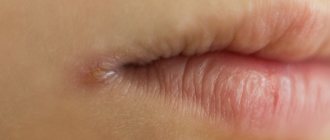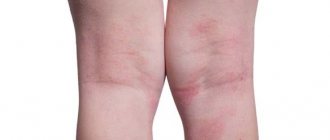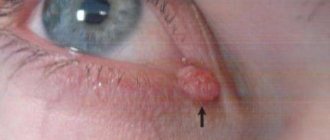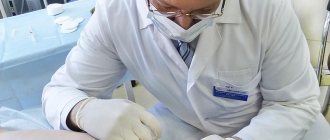Vesiculopustulosis (periporitis, osteoporitis) is one of the superficial forms of staphyloderma, which is characterized by purulent inflammation of the eccrine glands (the mouth of the sweat glands), which occurs in newborns.
In newborns under 1 year of age, staphylococcal skin lesions of non-follicular origin occur; the mouths of the sweat glands are especially often affected. If diagnosis and treatment are not timely, the process can quickly deepen with the formation of abscesses (pseudofurunculosis).
The group of staphyloderma in newborns is a fairly common phenomenon that requires extraordinary attention from pediatricians, dermatologists, and neonatologists, since limited forms can develop into generalized forms, which are extremely severe for the child’s body and can lead to fatal consequences.
Vesiculopustulosis is most often localized in the torso, scalp and skin folds.
Skin structure
The skin consists of three main layers: epidermis, dermis and hypodermis.
It acts as a protective shell around the human body. The topmost layer is the epidermis. It includes several layers of cells called keratinocytes. They begin life at the very bottom of the epidermis and then gradually move to the topmost layer. As soon as they come to the surface, they lose their nuclei, are filled with keratin and thus form the stratum corneum. This is a semi-permeable shield that consists of corneocytes connected by lipids and protein complexes. The stratum corneum serves as a barrier, protecting the body from external attacks.
The surface of the epidermis is covered with a mixture of sweat and sebum, referred to as a “hydrolipid film.” This oily substance moisturizes the skin and forms an antibacterial and antifungal barrier.
Located below the epidermis, the dermis serves as a supporting structure and gives the skin elasticity and firmness. Among other things, this layer contains elastin and collagen fibers.
The hypodermis is the deepest layer of the skin. It is mainly composed of fat cells called adipocytes, which protect the body from temperature fluctuations and form a “protective mattress” against the pressure to which the skin is subjected.
Specific features of newborn skin
A child's skin has the same structure as that of adults, but it does not yet have all its functions. Fragile and not yet fully developed, it takes three years to strengthen before it can properly perform its role as a protective barrier. These features are explained by several factors:
At birth, the pH of the skin is close to neutral. Gradually the pH decreases, becoming more acidic. This difference means that a child's skin is more sensitive to infections and irritations.
The hydrolipid film in infants is thinner than in adults. Therefore, it is less effective in protecting the epidermis from drying out and dehydration. As a result, the child's skin is much more vulnerable.
The stratum corneum is also more fragile. Corneocytes do not connect as well, meaning the layer is more permeable to external factors and infections. The dermis is three times thinner.
Relative to body weight, the surface area of a child's skin is 3 and 5 times greater than that of an adult. This means that the substance that manages to penetrate the skin becomes significantly more concentrated in the body, increasing the risk of toxicity.
New research has led to another major discovery regarding children's skin. The rich cell pool also distinguishes it from adult skin: the skin contains many special cells that are at their maximum strength at birth, but are extremely vulnerable in the first few years of life - the period during which the skin barrier is formed. This wealth of fragile cells is a valuable resource for a child’s skin.
After birth, the unprotected body of a baby is highly susceptible to pathogens that provoke the occurrence of purulent-inflammatory skin diseases. Neonatal vesiculopustosis is one such disorder.
Vesiculopustulosis (vesiculosis) is an infectious skin disorder in newborns. It is characterized by the appearance of a pustular rash on the body and a mild intoxication syndrome.
If treatment is started on time, the disease goes away quickly without any complications.
What causes vesiculopustulosis in newborns?
The main causes of vesiculopustulosis are damage to the integrity of the child’s skin. Also, the penetration of infection is possible in the prenatal period from mother to fetus if there are bacterial foci in the woman’s body.
Cost of consultation with a pediatrician in Moscow clinics:
- The first clinic of Izmailovo, Dr. Bandurina
1700 ₽
- Family Clinic
1950 ₽
- SM_clinic
2100 ₽
- Make an appointment by phone:
(499) 685-47-75
Another 159 clinics
Risk factors
There are certain conditions under which the likelihood of the addition of an infectious pathogen and the occurrence of vesiculopustulosis increases:
- acute or chronic staphylococcal infection in a pregnant woman;
- there is an unfavorable epidemiological situation in the hospital’s neonatal care units;
- poor hand hygiene among health care workers caring for and assisting infants;
- reduced protective system in weakened babies (premature birth, birth trauma, the presence of congenital or acquired pathologies);
- illiterate skin care (hypothermia or overheating, temperature conditions are not observed, there are diaper rashes, cracks, microtraumas on the skin, etc.);
- artificial feeding.
1.General information
Vesiculopustulosis occurs to one degree or another, if not in every newborn, then, in any case, very often, and is no longer perceived by many parents as a disease. Meanwhile, this is precisely a pathology, it has specific causes and a specific pathogen, and further development can vary, to put it mildly, within wide limits - up to very serious complications (see below).
Vesiculopustulosis (colloquially “pemphigus”) belongs to the group of pyodermas, i.e. purulent skin lesions, although in most cases it does not look as scary as it is formulated here. We are talking about yellowish-white multiple dots, which in the first days of a newborn’s life can be observed throughout the body or in some local area. With the right attitude and approach, in one or two, maximum three or four weeks, you can forget about the problem.
A must read! Help with treatment and hospitalization!
Types of disease
| Type | Time of occurrence | Causes/source of infection | Notes |
| Congenital | 1 – 3 days of life | Infection occurs through the maternal body if the pregnant woman has chronic infections or if she is a carrier of harmful microorganisms | The baby becomes infected while in the womb, but can also become infected during passage through the birth canal |
| Acquired | One week after birth | Occurs as a result of violation of hygiene rules in care | The risk group consists of prematurely born children, since their immunity is underdeveloped, and they are on artificial feeding, as a result of which the baby’s body does not receive the necessary antibodies that allow it to fight bacterial attack |
2. Reasons
Vesiculopustulosis is a fairly typical and commonplace infectious skin disease caused by pathogenic bacteria. Often the infection is combined, polymicrobial: laboratory tests reveal streptococci and pneumococci, Pseudomonas aeruginosa and Escherichia coli, Proteus, etc. However, in the case of classic neonatal vesiculopustulosis, the main pathogen is staphylococcus, so the term “staphyloderma” is often used as a synonymous diagnosis.
Of the three dozen known varieties of staphylococcus, four are dangerous to humans; In newborns, Staphylococcus aureus, or Staphylococcus aureus, is almost always sown.
Infection can occur in utero or in the birth canal; by contact method directly at birth, theoretically - by airborne droplets if the aseptic regime in the maternity hospital is not observed.
Risk factors include infantile immune system, prematurity, hyperfunction of sweat glands, underweight, artificial feeding, excessive swaddling and overheating.
Visit our Dermatology page
Symptoms
The initial signs of vesiculopustulosis, a red-pink pinpoint rash, can easily be mistaken for prickly heat.
If nothing is done at this stage, the following symptoms will occur:
- blisters no larger than a pea with redness around them. The bubbles are filled with a colorless liquid, and they are located near the mouths of the sweat glands;
- a few days later, the liquid in the blisters becomes cloudy, and pustules form;
- blisters rupture within 2–4 days, ulcers form, and then crusts.
The rashes are most often localized in the armpits, on the back of the head, in the hair, inguinal and buttock folds. Blisters tend to coalesce and spread quickly.
The child’s general well-being does not change. Temperature rises of 37 – 37.5 °C are rare.
Infants with a weakened protective system are characterized by a complicated form of the disorder.
In this situation, the manifestations are as follows:
- fever up to 39 °C;
- due to severe intoxication of the body, the area around the mouth dries out;
- The child’s anxiety increases and he is difficult to calm down;
- no appetite.
The number of blisters is determined by the degree of neglect of the disorder.
Symptoms and clinical picture of vesiculopustulosis in newborns
The most characteristic manifestations of vesiculopustulosis are the formation of small blisters filled with clear liquid, spreading throughout the body and scalp. After a few days, the blisters transform into a pustule with purulent contents, after which crusts begin to form.
Symptoms of vesiculopustulosis:
- formation of blisters with serous contents and redness around;
- temperature increase to 38-39 degrees;
- constant anxiety and tearfulness;
- refusal to feed;
- dry lips and mucous membranes of the oral cavity.
When adequate therapy is prescribed, the signs of vesiculopustulosis completely disappear.
Diagnostics
Vesiculopustulosis is diagnosed by a pediatrician. In this case, there is no need to perform laboratory tests and hardware examination.
- The specialist performs a physical examination.
- Interviews parents to find out the time of onset of pathology and symptoms.
If the disease is severe, the following will be prescribed:
- general blood test (with vesiculosis, a large number of leukocytes are detected);
- bacterial culture of the liquid formed in the bubbles (analysis will allow us to identify the causative agent of the disease and select the correct treatment).
The occurrence of various types of complications requires consultation with other specialists with a narrow focus:
- surgeon;
- infectious disease specialist;
- allergist;
- otolaryngologist.
In general, diagnosing the disease does not cause difficulties. The decisive point is the timely identification of the disorder so that the infection does not lead to the development of dangerous complications.
Etiology of vesiculopustulosis
The causative agent of vesiculopustulosis is considered to be bacteria of the genus Staphilicoccus, which are gram-positive cocci that, when smear microscopy, are capable of forming bunches of grapes. There are 3 main types: Staphylococcus aureus (S. Aureus), epidermal (S. Epidermidis), saprophytic (S. Saprophyticus). Staphylococci are quite resistant to the environment, but at a temperature of 100 ° C they die instantly, but tolerate low temperatures well. Regular disinfectant solutions kill bacteria in 15-20 minutes. Vesiculopustulosis is most often caused by Staphylococcus aureus and Staphylococcus epidermidis.
Complications
Complications develop if you do not consult a specialist in time and do not start treatment, and also when the child is weakened.
| Type of complication | Description | Treatment |
| Phlegmon | A purulent-inflammatory lesion of fatty tissue that does not have a clear boundary. The process tends to spread to surrounding tissues. Irreversible consequences may occur | The treatment is carried out by a surgeon. The disorder is difficult to treat. It involves the use of antibiotics and opening of purulent accumulations |
| Abscess | Pus accumulates in various tissues and has clear boundaries | Treated with antibiotics |
| Pseudofurunculosis | Severe inflammation in the sweat glands | Antibiotics and quality skin care |
| Sepsis | Infection of the blood due to the penetration of toxins and bacteria into it, as a result the entire body becomes infected | Treatment is carried out in the intensive care unit using strong antibiotics |
| Ostiomyelitis | Purulent bone tissue infection | Surgery, anti-inflammatory therapy |
| Pneumonia | Pneumonia | Antibacterial therapy in combination with the use of antitussives |
| Omphalitis | Inflammatory processes in the navel area | Daily rinsing with alcohol-based solutions and improved sanitation |
Which doctor treats vesiculopustulosis? Diagnostic methods
A diagnosis can be made based on a physical examination (examination), a survey of the mother, and test results. Upon examination, the doctor notes the characteristic location of the rash. Markers of inflammation appear in the blood test (increased leukocytes with a shift of the L-formula to the left, accelerated ESR). In severe cases, an increase in white blood cells is also observed in the urine.
To identify the causative agent, bacteriological culture of the discharge from the elements of the rash with sensitivity to antibiotics is performed. This makes it easier to select an antibacterial drug.
Treatment is carried out by a pediatrician, less often by a neonatologist or dermatologist. In severe cases of illness or unfavorable social factors, the child may be placed in an infectious diseases or pediatric department. Severe complications are treated in a surgical hospital.
Treatment
For mild cases of the disease, treatment can be carried out at home. When signs of complications are detected (for example, fever), it is recommended to carry out treatment in a hospital setting.
In any case, it is necessary to exclude the child’s contact with other people.
Treatment recommendations are as follows:
- baths with herbal decoctions, for example, chamomile, string, celandine, have a positive effect. These herbs have anti-inflammatory properties. However, it is recommended to bathe the child less often so that the disease does not spread to healthy areas of the skin. After bathing, smear her with hypoallergenic baby cream for children;
- twice a day, treat the damaged areas with brilliant green or a weak solution of potassium permanganate. This will prevent the spread of infection;
- large blisters are pierced with a needle pre-treated with alcohol, the pus is squeezed out, the wound is cauterized with an alcohol solution, then antibacterial ointment is applied;
- recommended antiseptic ointments for treating damaged skin: Lincomycin and Heliomycin;
- On the recommendation and under the supervision of a specialist, ultraviolet irradiation can be performed. Ultraviolet rays have a disinfecting effect;
- The baby's clothes and diaper must be kept clean and washed with mild hypoallergenic detergents. The linen is ironed on both sides to prevent other infections.
If the disease is severe, the baby is hospitalized and special therapy using antibiotics is prescribed. Tests are performed to identify the causative agent of the disease.
Cephalosporin antibiotics are usually prescribed. If necessary, immunomodulators are used. The dose is selected individually according to the age of the baby.
If the disease is advanced and complications develop, then another treatment is selected that is aimed at combating them.
Prevention
Taking into account the fact that vesiculopustulosis appears in newborns due to transmission of the pathogen from the mother, poor hygiene during care, and various manipulations involving contact with infant skin, preventive measures should be aimed at preventing infection of children's skin with pathogenic microorganisms.
Basic preventive measures:
- in a woman of childbearing age, foci of chronic infections are identified (dental caries, tonsillitis, otitis media, sinusitis, pyelonephritis, cystitis, etc.), and their sanitation is carried out before pregnancy;
- during pregnancy, foci of infection should also be identified and treated, and relapse prevention should be carried out;
- after birth, provide the child with proper care with high-quality hygiene;
- regular visits to the pediatrician;
- avoiding any contact with infected people.
Kinds
Depending on the time of onset of the disease, there are 2 types of vesiculopustulosis:
Congenital form
Manifestations of vesiculopustulosis occur on the first or second day after birth. Accordingly, the child was infected from a mother with chronic or untreated infections, in utero or during childbirth.
Acquired form
Acquired vesiculopustulosis develops on the 5-7th day of a baby’s life due to the presence of predisposing factors.










